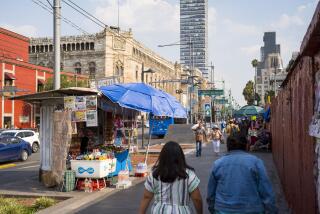Taking In Spain’s Storybook El Cid City, Burgos
- Share via
BURGOS, Spain — This is the storybook city of northern Spain: ruined castle, old town walls adorned with heroic statuary and bas-relief, fortified bridges, Gothic fountains along shaded paseos , a place where the very essence of Iberia hangs in the air just waiting to be inhaled.
Burgos is almost dead center of Old Castile, a former kingdom stretching from below Madrid to the northern Cantabrian Coast on the Atlantic.
The town is Gothic to the core, yet the cathedral, one of the most visually satisfying in Spain, reflects a lighthearted Spanish treatment of the style in arabesque flights of fancy, particularly in the delightful openwork of the main spires.
Burgos is the birthplace of the legendary El Cid--Rodrigo Diaz de Vivar, El Campeador--soldier of fortune and leader of Christian and Moor alike.
El Cid’s equestrian statue is a city landmark, his cape flying in the wind, his sword raised against the infidel.
Here to there: Iberia flies nonstop LAX-Madrid and Madrid-LAX every Sunday during summer, TWA regularly via New York. Or take a domestic carrier to Miami or New York for connections with Iberia or Aeromexico. No Mardrid-Burgos flights, but a first-class ticket by rail gets you there in less than three hours for about $15.
How long/how much? Give it a full day and night, at least. Hotel and dining prices are moderate, as they are in most of Spain.
A few fast facts: The peseta was recently valued at .007, about 143 to the dollar. Late spring through late fall are best times for a visit, the central meseta of Spain being raw in winter.
Getting settled in: Meson del Cid (Plaza Santa Maria 8 before the cathedral; $42 double high season, $35 low) is one of the loveliest places we’ve seen of late, only 3 years old but a study in period elegance, from its brass bedsteads with porcelain decorations down to the period fixtures in the baths. Best location in town, color TV, taberna downstairs and fine restaurant outside door.
Condestable (Calle Vitoria 8; $40 high, $34 low) is one of the town’s better hotels, a mix of contemporary and traditional with rooms on the smallish side, furnishings comfortable enough but not fancy. Full restaurant, good location.
A couple of visits to Hotel Espana (Paseo del Espolon 32; $26 high season, $22 low) have convinced us that it’s the town’s best value. At the end of a tree-lined main paseo with a friendly staff, comfortable rooms, good restaurant, and near the main plaza and cathedral.
Almirante Bonifaz (Vitoria 22; $43 high, $36 low) is a four-star hotel residencia , with breakfast only but most of the other amenities. Marble lobby and contemporary rooms really sparkle.
Regional food and drink: Spain is carnivore country, Castile even more so, yet seafood is invariably fresh anywhere it’s served. Cordero and cochinillo asado , roast lamb and suckling pig, are on every menu as are veal cutlets and chops. Try sopa de ajo , the garlic soup served hot in winter and chilled in summer. Entremeses variados will give you a taste of many of the region’s specialties to start your meal.
Burgos is on the edge of the Rioja region, home of Spain’s most noted wines, and those of the nearby Duero River valley are also excellent. Rioja reds are made to go with the region’s hearty meat dishes.
Moderate-cost dining: Casa Ojeda (Vitoria 5) is considered the city’s best, a beautiful old place with ceilings of carved wood panels, leaded windows, tile floors and a lively tapas bar on the ground floor. Alubias con chorizo y mirocilla , small white beans with spicy sausages, is a house speciality, along with cordero asado --both are heavenly. Such dishes will cost you $3.50 to $5, others up to $8.
Gaona (Paloma 41 beside the cathedral) is the seafood bastion of Burgos and has been for years. Crayfish are a local delicacy and you’ll find the freshest here. Five seafood and other combination plates run about $5, a trencherman’s menu for $10.
Meson de los Infantes (Arco de Santa Maria) is about as picturesque as they come, just below the gate leading into Cathedral Plaza. Count on the most tipico dishes here, such as Don Quixote’s olla podrida (rotten pot), a Castilian stew that must contain every meat and vegetable in the kitchen. Give it a try for $7.50, or the zarzuela de mariscos , an “operetta” of shellfish for $11. This is a good spot to look for callos a la burgalesa , tripe cooked in the hearty local style, and caracoles , snails that are often small and piled on a plate like beans.
On your own: After admiring the cathedral’s fanciful exterior, step inside for a treasure house of Gothic sculpture and lovely chapels, rose windows, the tomb of El Cid and other artworks dating from 1221 when construction began.
Arco de Santa Maria was begun in the 14th Century and is one of the most beautiful gateways in Spain. Walk the Paseo Espolon beside the river, perhaps stopping for a coffee at one of its many outdoor cafes, down to Plaza Miguel Primo de Rivera with its heroic statue of El Cid.
Often some of a town’s most enjoyable diversions are not found in guidebooks. Such was the case when we stumbled onto a summer carnival strung out along the riverbank in Burgos. The next three hours were spent among the colorful blinking lights, watching our daughter on every swirling ride, nibbling hot churros , making sure we had our fill of fresh Spanish potato chips, like none other in the world. If you don’t find a fair or carnival in Burgos during the summer, it’s sure to be in the next town you visit.
For more information: Call the Spanish National Tourist Office at (213) 658-7188, or write (8383 Wilshire Blvd., Suite 960, Beverly Hills 90211) for a 16-page booklet on Burgos with a city map, a map of Spain and a list of hotels. Ask for the Burgos package.
More to Read
Sign up for The Wild
We’ll help you find the best places to hike, bike and run, as well as the perfect silent spots for meditation and yoga.
You may occasionally receive promotional content from the Los Angeles Times.






